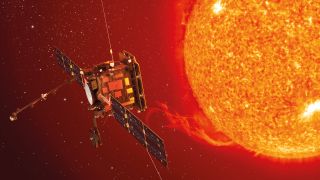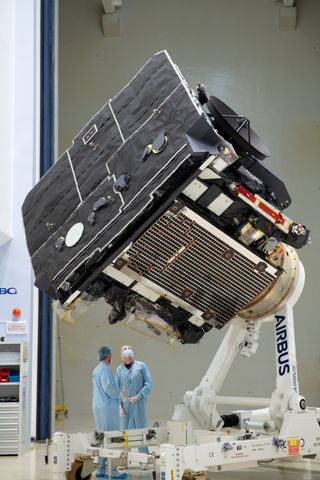
Scientists are about to get their first-ever good looks at the poles of the sun, which could be key to solving some long-standing solar mysteries.
The $1.5 billion Solar Orbiter, a European Space Agency (ESA) mission with strong NASA participation, is scheduled to launch atop a United Launch Alliance Atlas V rocket on the night of Feb. 7 from Cape Canaveral Air Force Station in Florida.
Once it's aloft, the 3,970-lb. (1,800 kilograms) spacecraft will use several flybys of Venus, and one of Earth, to get into an unusual orbit around the sun — one that is significantly out of the ecliptic, the plane in which Earth and the other big planets circle.
Related: Solar Quiz: How Well Do You Know Our Sun?
"Up until Solar Orbiter, all solar imaging instruments have been within the ecliptic plane or very close to it," Russell Howard, a space scientist at the Naval Research Lab in Washington, said in a statement.
"Now, we'll be able to look down on the sun from above," added Howard, who's principal investigator for Heliospheric Imager, one of Solar Orbiter's 10 science instruments.
This unique vantage point will help fill knowledge gaps, providing prodigious scientific returns during Solar Orbiter's seven-year mission, team members said.
Get the Space.com Newsletter
Breaking space news, the latest updates on rocket launches, skywatching events and more!
"The poles are particularly important for us to be able to model more accurately," Holly Gilbert, NASA project scientist for the mission at NASA's Goddard Space Flight Center in Greenbelt, Maryland, said in the same statement. "For forecasting space weather events, we need a pretty accurate model of the global magnetic field of the sun."
Solar Orbiter is launching just 18 months after another sun-studying mission, NASA's Parker Solar Probe (PSP), got off the ground. PSP has gotten much closer to the sun — 15 million miles (24 million kilometers) — than any other spacecraft to date, and it has traveled far faster as well.
This probe will continue to break both of those records, by the way. The NASA spacecraft will continue sculpting its orbit, significantly shaving down its close solar approaches. By the end of its seven-year mission, PSP will get within a mere 3.83 million miles (6.16 million km) of the solar surface and reach top speeds of around 430,000 mph (700,000 km/h) relative to the sun.

Solar Orbiter won't get nearly that close to our star; the probe's highly eccentric path takes it within 26 million miles (42 million km) of the solar surface on closest approach. But the more-distant viewing location provides important advantages, mission team members have said.
For example, the different vantage points of Solar Orbiter and PSP will allow scientists to compare observations of solar plasma and magnetic fields at different locations in space, providing valuable context. And Solar Orbiter can look directly at the sun and take pictures, which PSP is not equipped to do.
"You can't really get much closer than Solar Orbiter is going and still look at the sun," ESA Solar Orbiter project scientist Daniel Müller, of the European Space Research and Technology Center in the Netherlands, said in the same statement.
PSP and Solar Orbiter will, therefore, work well together in helping scientists better understand how the sun ticks, members of both teams have said. And these researchers aim to answer some pretty big questions — how the stream of charged particles known as the solar wind is accelerated to such tremendous speeds, for example, and how exactly the sun's internal dynamo works.
"We are learning a lot with Parker, and adding Solar Orbiter to the equation will only bring even more knowledge," Teresa Nieves-Chinchilla, NASA deputy project scientist for Solar Orbiter at Goddard Space Flight Center, said in the same statement.
The cooperation will start soon. Solar Orbiter is scheduled to begin making science measurements in May, mission team members said. (Full science operations won't commence until November 2021, however, when the probe's telescopic imagers will come fully online.)
And given the length of both missions, the collaboration should continue through at least the mid-2020s, representative said.
"It's definitely a golden age," Nicky Fox, Heliophysics Division director in the Science Mission Directorate at NASA headquarters in Washington, said during a news conference today (Jan. 27). "It's definitely the time to study solar physics."
- NASA's Parker Solar Probe Mission to the Sun in Pictures
- Here's What Earth Looks Like When You're Heading to the Sun
- Launch Photos! NASA's Parker Solar Probe Blasts Off to Touch the Sun
Mike Wall's book about the search for alien life, "Out There" (Grand Central Publishing, 2018; illustrated by Karl Tate), is out now. Follow him on Twitter @michaeldwall. Follow us on Twitter @Spacedotcom or Facebook.

Join our Space Forums to keep talking space on the latest missions, night sky and more! And if you have a news tip, correction or comment, let us know at: community@space.com.

Michael Wall is a Senior Space Writer with Space.com and joined the team in 2010. He primarily covers exoplanets, spaceflight and military space, but has been known to dabble in the space art beat. His book about the search for alien life, "Out There," was published on Nov. 13, 2018. Before becoming a science writer, Michael worked as a herpetologist and wildlife biologist. He has a Ph.D. in evolutionary biology from the University of Sydney, Australia, a bachelor's degree from the University of Arizona, and a graduate certificate in science writing from the University of California, Santa Cruz. To find out what his latest project is, you can follow Michael on Twitter.
